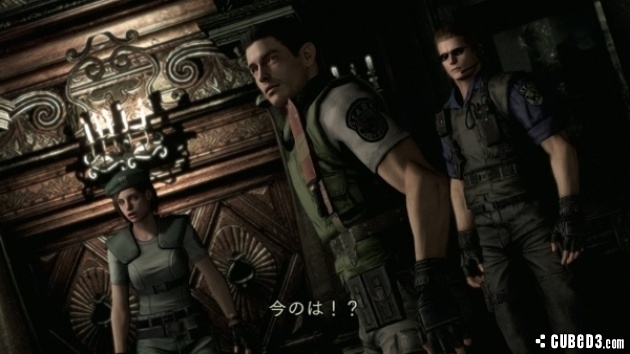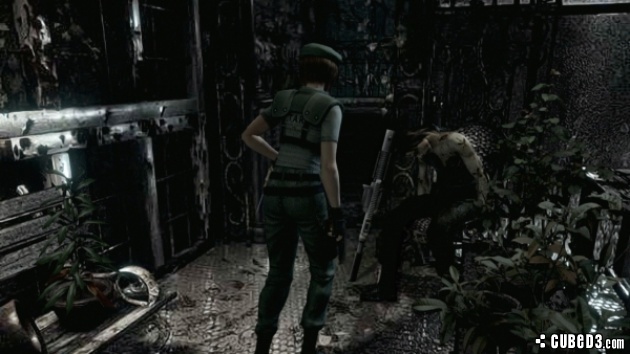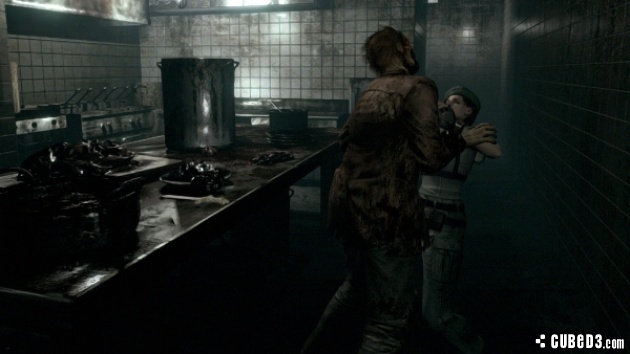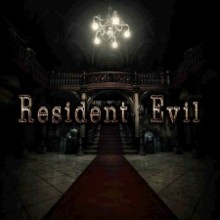Biohazard HD Remaster (PlayStation 3) Review
By Coller Entragian  11.12.2014
11.12.2014

Shinji Mikami has often been labelled as the "godfather of survival-horror." He is responsible for creating Resident Evil/Biohazard, Dino Crisis and most recently The Evil Within/Psycho Break. Shinji Mikami's humble beginnings as a game designer go back as far as the Super Nintendo game Goof Troop, and with a discerning eye, some of his flourishes for intricate level design and puzzle-based exploration can be seen in that game. Going as far back as 1989, Capcom released a Famicom game known as Sweet Home, a movie tie-in game from a film that can be best described as "Japanese Poltergeist." At its core, Sweet Home was an RPG, with turn-based battles, but it laid the framework that would define Shinji Mikami's career, as well as the birth of a sub-genre and lead to one of the most important franchises in Capcom's portfolio that isn't named Street Fighter. While Sweet Home may look like a Dragon Quest clone with a horror veneer, it pioneered concepts found in Resident Evil, such as: door-opening transitions, character-specific tools/items, perma-deaths for characters that affect the ending, limited inventory space, labyrinthine mansion exploration, cryptic environmental puzzles and, of course, unbelievably challenging enemies.
When the first Resident Evil/Biohazard came out in the 90s on the PlayStation, it was clearly inspired by Alone in the Dark, as well as Sweet Home, but what made it endure was its creepy B-movie atmosphere (inspired by George Romero), fantastic level design and its challenging gameplay. In 2002, Shinji would greatly revise and expand his original concept on the Nintendo GameCube into what many consider to be the most terrifying survival-horror game of all time. More than a decade later, with Shinji Mikami long gone from Capcom, and the heads of Capcom completely dumbfounded in how to bring Resident Evil back to its roots to save it, Capcom remasters the GameCube classic. Cubed3 enters the survival horror in this review of the Asian version of Resident Evil HD Remaster on PlayStation 3.
Shinji Mikami's greatest survival horror masterpiece was released in 2014 and sadly it was not The Evil Within. For a game made in 2002 on GameCube hardware, Resident Evil is still looking fantastic thanks to its realistic pre-rendered backdrops and highly detailed character models that look even better and more detailed than what was in Resident Evil 6 or even The Evil Within!
Now remastered in HD, Resident Evil HD Remaster is an impeccable looking game with some very believable looking human characters and some of the most realistic and tightly controlled, weighty character animations. What was originally a standard definition game with fuzzy backdrops has been greatly enhanced with crystal-like clarity and newly implemented lighting effects that really sell the dark and intensely moody gothic atmosphere.
It's impressive how Capcom's team was able to make these old backdrops, which are now more than a decade old, look so rich and clean, and even more so the added atmospheric effects like smoke and what looks like bloom lighting. Some of the finest lighting effects are on display here - even if it is running only 720p, it manages to look very sharp and has a chiaroscuro style to its use of blacks.

Resident Evil HD Remaster is a very impressive display. However, there are some textures left that still are a tad muddy. While the odd nit-pick of a stray low-res texture is not so distracting, the few frame rate drops are certainly noticeable. For the most part, Resident Evil HD Remaster runs a very stable 30fps, but in some areas it becomes slightly choppy and it does affect the immersion. It is disappointing that this title, which is a GameCube game that is over a decade old, manages to have frame rate issues on PS3 architecture.
It should be noted that the Wii port of the GameCube version does play on the Wii U, and while it does not have the beautiful HD backdrops and new effects, it does have the frame rate that does not falter. Of course, the Wii port is also only playable in 4:3 ratio. While the new widescreen pan and scan for Resident Evil HD Remaster does look nice and has some pretty smooth movements, the game was never designed to be viewed with so much information being cropped off, and does affect the gameplay negatively. Thankfully, 4:3 aspect ratio is preserved as an option.
While Resident Evil HD Remaster looks fantastic and runs mostly fine, everything else has been left intact. The story has remained unchanged and still holds up as a simple yet effective survival story where things go really bad. The thing with Resident Evil is that the story or characters was never really the point of the game; it was always about the situations and whether the player could survive.
The most significant change to the way the zombies behave is that they will only be killed by a critical headshot or if players burn the bodies. Not burning the remains of zombies will result in them slowly transforming into a greater threat - a crimson head. These horrible creatures are faster, stronger and will make short work of the player.
Since this game was designed during a time where this kind of unforgiving gameplay was more openly accepted, expect very limited resources, which mean players will not be able to burn every zombie. It is this kind of ingenious design that makes Resident Evil HD Remaster such a harrowing and intense nightmare. Careful planning, resource management and strategic manoeuvring is what makes Resident Evil HD Remaster one of the best examples of what makes survival-horror so appealing.

Unlike most survival-horror titles today, Resident Evil HD Remaster offers players a great deal of agency and does not hold the player's hand. This is most evident in the earlier moments of the game where it is at its most open ended. Navigating the Spencer mansion and figuring out the safest and most open route is one of the core pillars of survival-horror, and the anxiety felt from getting lost or disoriented feels very real.
This is where some of the genius of the fixed camera angles that helped define the genre for the better part of a decade comes in. The angles chosen for this game truly do give an air of unease and at times, can feel like someone is watching Chris/Jill. It's a very subtle touch that most take for granted, but this is true cinematic gameplay. Consider how in most games where the camera is locked around a player character. Games like Resident Evil 6 or the more recent The Last of Us use such camera systems, and such games are praised for their "cinematic gameplay," which is, in fact, a misnomer. There is nothing cinematic about a camera that stays on one subject. No; cinema or film is a language that is made up of careful framing and editing or cuts.
Resident Evil HD Remaster is a game that speaks the language of cinema. Consider how each backdrop is a carefully framed shot, where players move their characters between each shot - this creates the illusion of editing and the passage of time. This is true cinematic gameplay because it actually is like playing with the mechanics of the language of cinema: composition and editing. This is something that the original Resident Evil and Alone in the Dark pioneered way back in the 90s, and even today this effect is still a very effective means to make the player feel a certain way when playing.

Resident Evil HD Remaster is a highly recommended game that can now be enjoyed by those who are turned off by the notion of tank-controls. Thankfully, the original control scheme is still intact for those who wish to play the game the way it was intended, but the alternate control scheme works as a fine option for those who never liked Resident Evil's control setup. While the alternate controls work well for the most part it does have some issues - namely that characters will run at full speed when the analogue stick is pushed all the way and there is no option to set it to having a run button instead. The ability to walk is crucial in Resident Evil HD Remaster, since it is not an action game and there are many traps. Considering how Chris and Jill have only two speeds - walk or run - it can be very tricky to maintain a walk in this game with no setting for having a run button.
Another disadvantage for the alternate controls is that each time the camera cuts or does an edit, it resets the relative directions on the controls. With the classic controls, the relative direction is always corresponding with the character's direction making navigating always easy and maintains orientation.
Some new additions to Resident Evil HD Remaster's control setup that did make the game slightly better is the tactical weapon reloading, so players don't have to go to the inventory to reload their weapon. This change is by far one of the most convenient and logical additions to this remaster.
In addition to these extra options, there are the BSAA costumes for Chris and Jill from Resident Evil 5 included as bonuses, but other than that, Capcom did not spare much expense at adding other substantial extras. One change that should have been implemented is the option to skip door-opening transitions - they are meant to be a means to segue players to new areas to prevent disorientation and actually are not load screens anymore. The fact that they are skippable in Resident Evil: Deadly Silence, the Nintendo DS port of the PS1 game, means that it was a viable option.

Cubed3 Rating
Exceptional - Gold Award

While The Evil Within was supposed to be the survival-horror title that was Shinji Mikami's opus, it was the remastering of his immortal classic that will be the one people will remember from 2014. With accessible control options that make it so absolutely anyone can handle it, there is no longer any excuses for this incredible game to be passed on. While there are some minor hiccups with the frame rate in some areas, and an oversight to make door-opening transitions skippable, this is the best game Capcom has put out since Strider 2014. Capcom really needs to pay attention to what made this title so great, and since they are acknowledging its greatness with this remastering, it paints a more hopeful future for what was once a great franchise. With so few quality survival-horror titles, it is a miracle that something like Resident Evil HD Remaster exists.
Comments
Comments are currently disabled

 Sign In
Sign In Game Details
Game Details
 Out now
Out now  Out now
Out now  Out now
Out now  Out now
Out now  Subscribe to this topic
Subscribe to this topic Features
Features





 Top
Top

